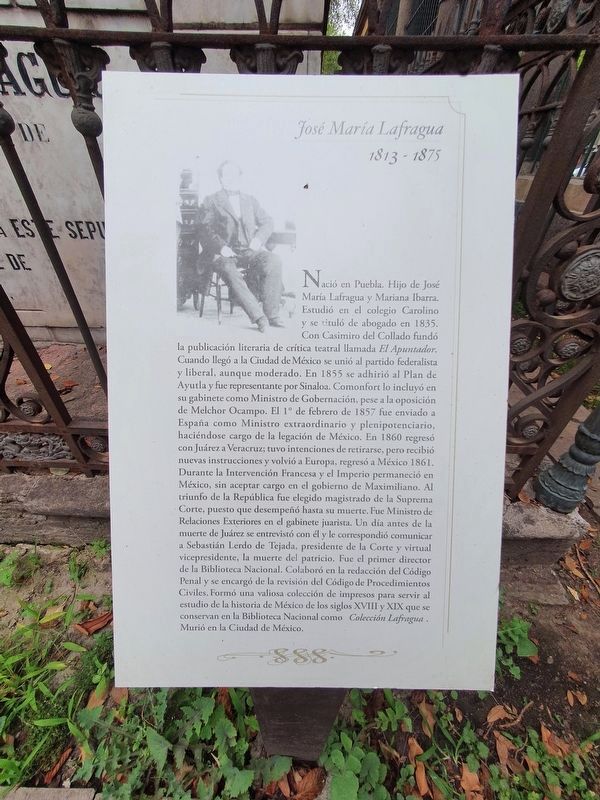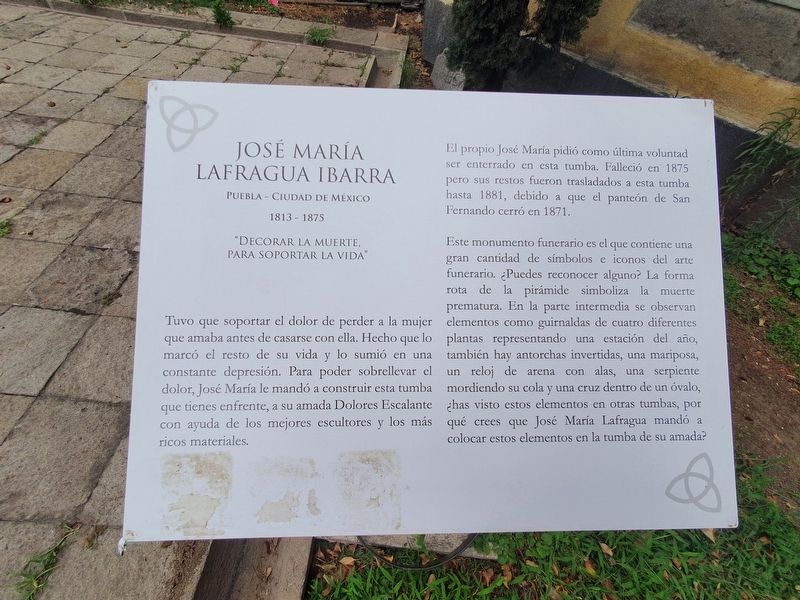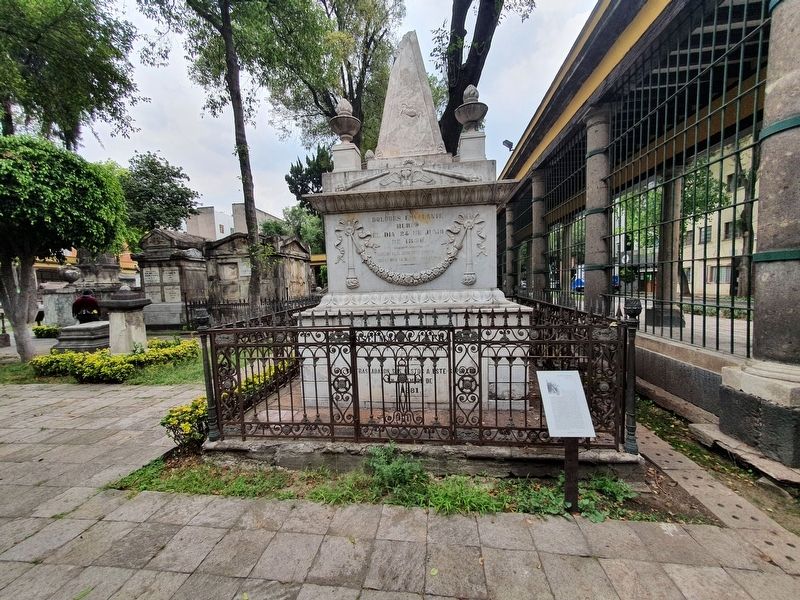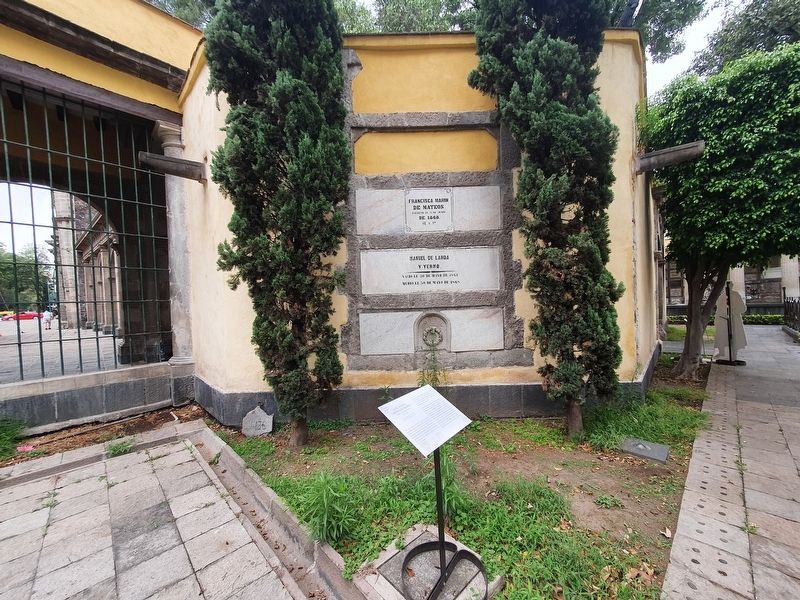Centro Histórico in Hervidero y Plancha in Mexico City, Mexico — The Valley of Mexico (The Central Highlands)
José María Lafragua
1813-1875
Nació en Puebla. Hijo de José María Lafragua y Mariana Ibarra. Estudió en el colegio Carolino y se tituló de abogado en 1835. Con Casimiro del Collado fundó la publicación literaria de crítica teatral llamada El Apuntador. Cuando llegó a la Ciudad de México se unió al partido federalista y liberal, aunque moderado. En 1855 se adhirió al Plan de Ayutla y fue representante por Sinaloa. Comonfort lo incluyó en su gabinete como Ministro de Gobernación, pese a la oposición de Melchor Ocampo. El 1° de febrero de 1857 fue enviado a España como Ministro extraordinario y plenipotenciario, haciéndose cargo de la legación de México. En 1860 regresó con Juárez a Veracruz; tuvo intenciones de retirarse, pero recibió nuevas instrucciones y volvió a Europa, regresó a México 1861. Durante la Intervención Francesa y el Imperio permaneció en México, sin aceptar cargo en el gobierno de Maximiliano. Al triunfo de la República fue elegido magistrado de la Suprema Corte, puesto que desempeñó hasta su muerte. Fue Ministro de Relaciones Exteriores en el gabinete juarista. Un día antes de la muerte de Juárez se entrevistó con él y le correspondió comunicar a Sebastián Lerdo de Tejada, presidente de la Corte y virtual vicepresidente, la muerte del patricio. Fue el primer director de la Biblioteca Nacional. Colaboró en la redacción del Código Penal y se encargó de la revisión del Código de Procedimientos Civiles. Formó una valiosa colección de impresos para servir al estudio de la historia de México de los siglos XVIII y XIX que se conservan en la Biblioteca Nacional como Colección Lafragua. Murió en la Ciudad de México.
José María Lafragua Ibarra
Puebla - Ciudad de México
1813-1875
"Decorar la muerte, para soportar la vida"
Tuvo que soportar el dolor de perder a la mujer que amaba antes de casarse con ella. Hecho que lo marcó el resto de su vida y lo sumió en una constante depresión. Para poder sobrellevar el dolor, José María le mandó a construir esta tumba tienes enfrente, a su amada Dolores Escalante con ayuda de los mejores escultores y los más ricos materiales.
El propio José María pidió como última voluntad ser enterrado en esta tumba. Falleció en 1875 pero sus restos fueron trasladados a esta tumba hasta 1881, debido a que el panteón de San Fernando cerró en 1871.
Este monumento funerario es el que contiene una gran cantidad de símbolos e iconos del arte funerario. ¿Puedes reconocer alguno? La forma rota de la pirámide simboliza la muerte prematura. En la parte intermedia se observan elementos como guirnaldas de cuatro diferentes plantas representando una estación del año, también hay antorchas invertidas, una mariposa, un reloj de arena con alas, una serpiente mordiendo su cola y una cruz dentro de un óvalo, ¿has visto estos elementos en otras tumbas, por qué crees que José María Lafragua mandó a colocar estos elementos en la tumba de su amada?
José María Lafragua
1813-1875
Born in Puebla. Son of José María Lafragua and Mariana Ibarra. He studied at the Carolino College and graduated as a lawyer in 1835. With Casimiro del Collado he founded the literary publication of theatrical criticism called El Apuntador. When he arrived in Mexico City he joined the Federalist and Liberal party, albeit as a moderate. In 1855 he adhered to the Plan of Ayutla and was representative for Sinaloa. Comonfort included him in his cabinet as Minister of the Interior, despite the opposition of Melchor Ocampo. On February 1, 1857, he was sent to Spain as Minister Extraordinary and Plenipotentiary, taking charge of the legation of Mexico. In 1860 he returned with Juárez to Veracruz; he intended to retire, but received new instructions and returned to Europe, returning to Mexico in 1861. During the French Intervention and the Empire he remained in Mexico, not accepting a position in the government of Maximilian. At the triumph of the Republic he was elected magistrate of the Supreme Court, a position he held until his death. He was Minister of Foreign Affairs in the Juarista cabinet. A day before Juárez's death, he met with him and it was up to him to inform Sebastián Lerdo de Tejada, president of the Court and virtual vice president, of the death of the patrician. He was the first director of the National Library. He collaborated in the drafting of the Criminal Code and was responsible for the revision of the Code of Civil Procedure. It formed a valuable collection of printed matter to serve the study of the history of Mexico of the eighteenth and nineteenth centuries that are preserved in the National Library as the Lafragua Collection. He died in Mexico City.
José María Lafragua Ibarra
Puebla - Mexico City
1813-1875
"Decorate death, to endure life"
He had to endure the pain of losing the woman he loved before marrying her. This fact marked him for the rest of his life and plunged him into a constant depression. In order to cope with the pain, José María had this tomb built for his beloved Dolores Escalante with the help of the best sculptors and the richest materials.
José María himself asked in his will to be buried in
this tomb. He died in 1875 but his remains were not moved to this tomb until 1881, because the pantheon of San Fernando closed in 1871.
This funerary monument is the one that contains a large number of symbols and icons of funerary art. Can you recognize any? The broken shape of the pyramid symbolizes premature death. In the middle part there are elements such as garlands of four different plants representing a season of the year, there are also inverted torches, a butterfly, an hourglass with wings, a snake biting its tail and a cross inside an oval. Have you seen these elements in other tombs? Why do you think José María Lafragua ordered to place these elements on the tomb of his beloved?
Topics. This historical marker is listed in this topic list: Government & Politics. A significant historical date for this entry is February 1, 1857.
Location. 19° 26.341′ N, 99° 8.884′ W. Marker is in Hervidero y Plancha, Ciudad de México (Mexico City). It is in Centro Histórico. Marker can be reached from Calle San Fernando, on the right when traveling west. The marker is on the grounds of the Panteón San Fernando. Touch for map. Marker is at or near this postal address: C San Fernando 17, Hervidero y Plancha CDMX 06300, Mexico. Touch for directions.
Other nearby markers. At least 8 other markers are within walking distance of this marker. Manuel Ruiz (here, next to this marker); Ignacio Comonfort (here, next to this marker); Tomás Mejía (here, next to this marker); Ignacio Zaragoza (a few steps from this marker); Vicente Guerrero (a few steps from this marker); Juan de la Granja (a few steps from this marker); Lino José Alcorta (a few steps from this marker); Mariano Riva Palacio (a few steps from this marker).
Credits. This page was last revised on May 11, 2023. It was originally submitted on March 2, 2023, by J. Makali Bruton of Accra, Ghana. This page has been viewed 120 times since then and 58 times this year. Photos: 1, 2, 3, 4. submitted on March 2, 2023, by J. Makali Bruton of Accra, Ghana.



